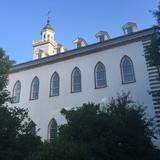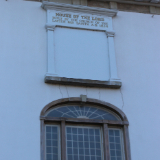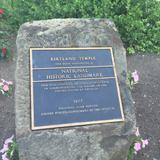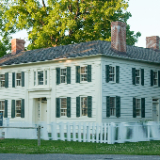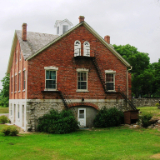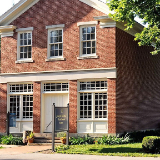Author: saedgar
Frequently Asked Questions
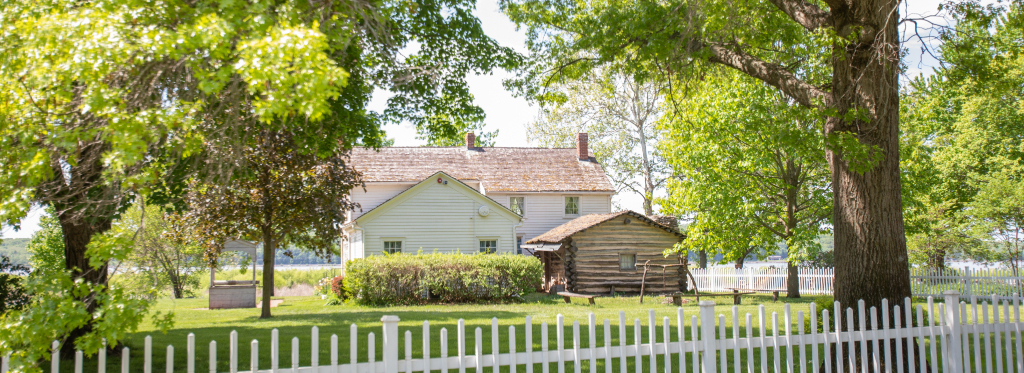
News Release
Frequently Asked Questions Clarify the Transfer of Sacred Sites and Historic Documents
(See Appendix below for a list of items transferred!)
1. What was included in the transaction? The transaction involves land, buildings, artifacts, and documents. The real estate, along with some artifacts, are in Kirtland, Ohio, and Nauvoo, Illinois, while artifacts and documents also come from Community of Christ Library and Archives in Independence, Missouri.
2. What are the most significant items? The most significant properties are the Kirtland Temple, the Smith Family Homestead, the Mansion House, the Nauvoo House, and the Red Brick Store. Significant documents and artifacts include manuscripts and the Bible used in the Joseph Smith Translation of the Bible, seven letters from Joseph Smith to his wife Emma, John Whitmer’s history of the Church, original portraits of Joseph and Emma Smith, the cornerstone of the Nauvoo House, the original door of Liberty Jail, and a document with the title of “Caractors,” which may contain a sample of inscriptions from the gold plates. (See the appendix for a more detailed list of items transferred.)
3. How did Community of Christ acquire these materials?
After the Saints left Kirtland in the 1830s, different parties controlled access to the temple over the years. In 1901, Community of Christ, then known as the Reorganized Church of Jesus Christ of Latter Day Saints (“RLDS Church”) secured title to the Kirtland Temple through legal proceedings. The Smith family properties in Nauvoo remained in possession of Emma Smith after Joseph Smith’s death and she and her children eventually joined the RLDS Church. Thereafter, the properties passed through family connections to the RLDS Church. Other documents and artifacts were donated to the RLDS Church archives by their individual owners.
4. Why did Community of Christ sell these materials now?
As Community of Christ President Stephen M. Veazey noted in the joint statement, the transfer of materials at this time enables their mission and priorities around the world.
5. Why did The Church of Jesus Christ of Latter-day Saints purchase these materials?|
The sites and artifacts in this transaction relate to significant events and people in the Restoration of the gospel of Jesus Christ.
6. What is the relationship between the two churches?
The two churches enjoy a strong, respectful, and friendly relationship. For many decades, we have collaborated on numerous historical and humanitarian projects.
7. Have there been previous transactions of historic materials between the two churches?
Yes. In 2012, Community of Christ sold to the Church of Jesus Christ several properties, including the Hawn’s Mill Massacre site and the Joseph and Emma Smith home in Kirtland. Five years later, Community of Christ sold the Printer’s Manuscript of the Book of Mormon to the Church of Jesus Christ.
8. What was paid for the properties, artifacts, and documents?
The Church paid US$192.5 million without assigning specific values to the properties and items.
9. Will the historic sites be open to the public?
Yes. The historic buildings in Kirtland and Nauvoo closed on March 5, 2024, to facilitate the transfer of ownership and will reopen to the public on March 25, 2024. Tours will be provided of the Kirtland Temple, the Smith Family Homestead, the Mansion House, and the Red Brick Store. Updated visitor information will be published on the historic site webpages for Historic Kirtland and Historic Nauvoo.
10. Will admission be charged to visit the sites?
No. All of the Church of Jesus Christ’s historic sites are open to the public at no charge.
11. Will members of Community of Christ continue to have access to the sites?
Yes. The sites will be open to the public generally. The Church has also made specific arrangements with Community of Christ to allow for special meetings and gatherings over the coming years.
12. Will the Kirtland Temple be converted into a functioning Latter-day Saint temple?
No. The Kirtland Temple will be maintained and presented as a historic building that is open to the public. President Russell M. Nelson announced a temple in Cleveland in April 2022, and the Church released its site address in December 2022 and a rendering in July 2023.
13. Will the Church continue to pursue development of its proposed new visitors’ center near the Nauvoo Temple?
Yes. The proposed visitors’ center in Nauvoo will orient visitors to the historic and contemporary significance of the Nauvoo Temple. The use of the other two visitors’ centers in Nauvoo will be determined in the future.
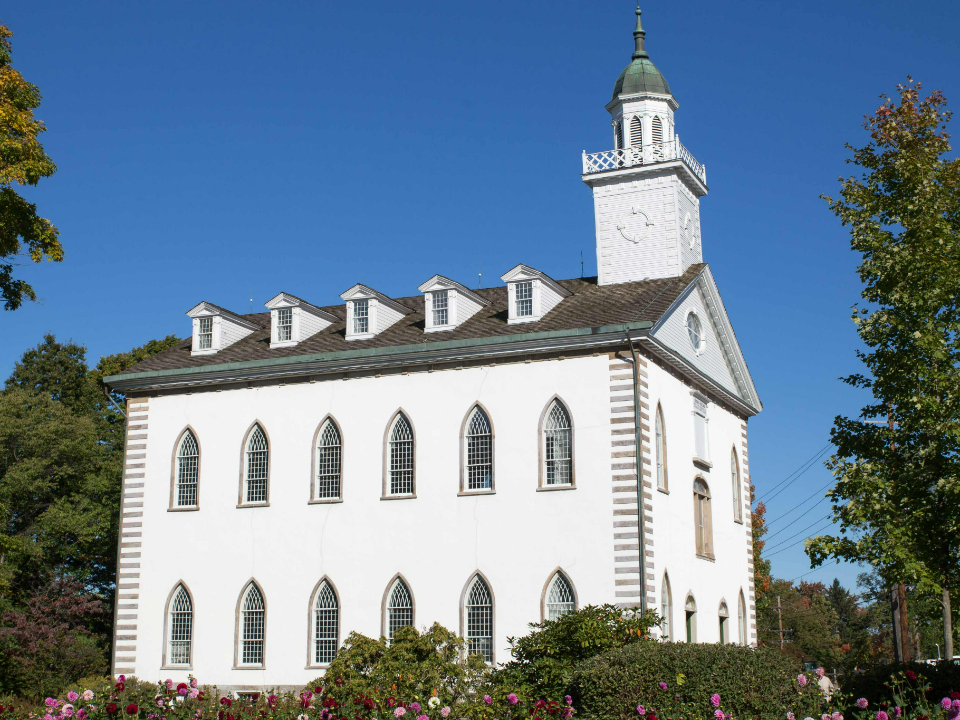
| The Kirtland Temple was the first temple built by the Saints in the latter days. 2024 by Intellectual Reserve, Inc. All rights reserved. |
Appendix: List of Items Transferred
Historic Buildings that Will Remain Open to the Public in Kirtland, Ohio: Kirtland Temple, 9020 Chillicothe Road
Historic Buildings that Will Remain Open to the Public in Nauvoo, Illinois: Smith Family Homestead and Summer Kitchen, 935 South Main Street
Joseph and Emma Smith Mansion House, 890 South Main Street
Red Brick Store (reconstructed), 610 Water Street
Nauvoo House, 950 South Main Street
Historical Artifacts:
Portraits of Joseph and Emma Smith, circa 1842, attributed to David Rogers
Original door of Liberty Jail, circa 1833
Book of Mormon “Caractors” document
Four pages from Revelation Book 1, including portions of revelations now known as Doctrine and Covenants 64, 65, 66, 76, 81, and 133
Seven letters from Joseph to Emma Smith, including letters written on 13 October 1832, 18 May 1834, 4 November 1838, 12 November 1838, 9 November 1839, 23 June 1844, and 27 June 1844
A history of the church, written by John Whitmer
Manuscript notes of 1879 interview with Emma Smith by Joseph Smith III
Joseph Smith’s printed “Phinney” Bible (Cooperstown, New York, 1828) with his numerous markings as part of the Joseph Smith Translation of the Bible
Manuscripts of the Joseph Smith Translation of the Bible:
Old Testament manuscript 1 (June 1830–7 March 1831)
Old Testament manuscript 2, first part (8 March–5 April 1831)
Old Testament manuscript 2, second part (20 July 1832–2 July 1833)
Old Testament manuscript 3 (ca. late 1830–early 1831)
New Testament manuscript 1 (8 March–June 1831)
New Testament manuscript 2, Folio 1 (4 Apr 1831–26 Sep 1831)
New Testament manuscript 2, Folio 2 (26 Sep 1831–late 1831)
New Testament manuscript 2, Folio 3 (winter 1831–1832)
New Testament manuscript 2, Folio 4 (January/February 1832–31 July 1832)
Publication committee manuscripts for the first complete edition of the Joseph Smith Translation of the Bible as The Holy Scriptures (1867)
Joseph Smith writing desk (Kirtland Temple)
1820s couch associated with the Whitney family (Kirtland Temple)
Original elements of the Kirtland temple:
Oval window frame
Front door keystone and frame
Stone arch
Windows
Pieces of original stucco and sandstone
Nauvoo Temple Sunstone
Two Nauvoo Temple Moonstones
Nauvoo House cornerstone, which housed the Original Manuscript of the Book of Mormon
Joseph Smith desk (Mansion House)
Emma Smith trunk (Mansion House)
Lucy Mack Smith rocking chair (Mansion House)
Two Smith family chairs (Mansion House)
Emma Smith walking stick (Homestead)
Washstand associated with Hawn’s Mill (Homestead)
Sampler (Homestead)
Bowl (Homestead)
Three inkwells (Red Brick Store)
In addition, the transfer includes the vast majority of representative period artifacts that are currently on display in the historic buildings (most of these artifacts are not historically associated with the Smith family or with Nauvoo).
Non-Historic Buildings in Kirtland
Temple Visitor’s Center, 9076 Chillicothe Road
Private residence and shop, 7788 Maple Street
Private residence, 7799 Joseph Street
Private residence, 9120 Timothy Lane
Small Undeveloped Lots in Kirtland
[unnumbered] Joseph Street
9080 Chillicothe Road
Historic Buildings with Modernized Interiors in Nauvoo (Private Use)
Hiram and Thankful Clark home, 790 South Hyde Street
Aaron and Polly Johnson home, 475 Water Street
William and Rosannah Marks home, 575 Water Street
Sidney and Phebe Rigdon home, 860 South Main Street
Jonathan and Rebecca Wright home, 455 Water Street
The First Hotel, 795 South Main Street
A stone stable built by Lewis Bidamon, 940 South Main Street
Non-Historic Buildings in Nauvoo
Maintenance Shop, Bain Street
All Nauvoo Blocks and Lots (indexed to the 1842 Map of the City of Nauvoo)
Block 137, Lot 4 – no structures
Block 138 – no structures
Block 139, lots 3-4 – includes the First Hotel
Block 140, lots 3-4 – no structures
Block 145 – no structures
Block 146 – includes the Joseph Smith Historic Site Visitor’s Center (initially leased by the Church and subject to a secondary closing at a later date), James and Sally Brinkerhoff former home site, and Levi and Clarissa Hancock former home site
Block 147 – includes the Mansion House, Rigdon home, Clark home, Samuel and Levira Smith former home site, and Theodore and Frances Turley former home site
Block 148 – includes the William Law store former site
Block 149 – includes the Marks home, public restrooms, a Hyrum Smith office former site, and the Times and Seasons newspaper office former site
Block 150 – includes the Johnson home, Wright home, maintenance shop
Block 153 – no structures
Block 154 – includes a Hyrum Smith office former site
Block 155 – includes the Red Brick Store and the Smith Homestead and summer kitchen; does not include the Smith Family Cemetery
Block 156 – includes the Nauvoo House, Bidamon stable, Joseph Smith red brick stable former home site, Joseph Sr. and Lucy Smith former home site, Porter Rockwell former home site, and a parking area
Block 157 – no structures
Block 158, lots 2-3 – includes private residence (960 South Partridge Street)
Block 161 – no structures
Block 162 – no structures
Additional Resources
Kirtland Ohio: Historic Background and Insights
Presented by Karl Ricks Anderson, historian and Kirtland Ohio Stake patriarch. Karl Anderson is an expert on the Kirtland period of Church history. He powerfully demonstrates that the Savior personally and visibly directed His Church and taught His Saints by showing Himself or speaking to at least twenty-five early leaders in about twenty separate visions or manifestations attested to in Kirtland. Although early Church members loved and followed the Prophet Joseph Smith, they recognized that the Savior was their leader. Anderson points out that more first-person words of the Lord have gone to the world from Kirtland than from any other location in our history. He also shares his understanding of the Kirtland Temple, the first latter-day House of the Lord—with the Savior’s promise that He would manifest Himself to His servants there, and he explores the visions, symbolism, and endowment given there.
Click Here to return to the “Huge Historic Update”
Click Here to return to my Blog Home Page.
Deseret News Article
“Church purchases Kirtland Temple, other historic buildings and artifacts from Community of Christ.”
‘We are deeply honored to assume the stewardship of these sacred places, documents and artifacts,’ says President Russell M. Nelson.

The Church of Jesus Christ of Latter-day Saints has purchased the Kirtland Temple — the first temple built in this dispensation — from the Community of Christ church, leaders of both faiths announced Tuesday, March 5, in a joint statement.
The landmark agreement also includes the purchase of several significant buildings in Nauvoo, Illinois, and important manuscripts and artifacts.
“Together, we share an interest in and reverence for these historic sites and items and are committed to preserving them for future generations,” wrote the leaders in the statement, dated March 5.
Discussions leading to this agreement have been ongoing since June 2021, according to the statement.
“We are deeply honored to assume the stewardship of these sacred places, documents and artifacts,” said President Russell M. Nelson, President of The Church of Jesus Christ of Latter-day Saints. “We thank our friends at Community of Christ for their great care and cooperation in preserving these historical treasures thus far. We are committed to doing the same.”
Community of Christ President Stephen M. Veazey said the exchange of assets is significant for his church. “Through funding from increased endowments, Community of Christ will have greater capacity to pursue our mission priorities around the world, including continuing to fulfill the divinely envisioned purposes for our temple in Independence, Missouri.”
The Kirtland Temple will remain a historic building and will not be converted into an operating Latter-day Saint temple, according to the question-and-answer statement released by the Church of Jesus Christ and the Community of Christ.
The Kirtland Temple, as well as the other historic buildings — all in Nauvoo — closed March 5 to facilitate the transfer of ownership and will reopen to the public on March 25.
More details about the transaction, assets and other items included in the agreement will be forthcoming, according to the statement.

The historic sites and artifacts in this transaction “relate to significant events and people in the Restoration of the gospel of Jesus Christ,” according to the statement.
The most significant properties are:
-
- Kirtland Temple.
- Smith Family Homestead.
- Mansion House.
- Nauvoo House.
- Red Brick Store.
Significant documents and artifacts include:
-
- Manuscripts and the Bible used in the Joseph Smith Translation of the Bible.
- Seven letters from Joseph Smith to his wife Emma.
- John Whitmer’s history of the Church.
- Original portraits of Joseph and Emma Smith.
- The cornerstone of the Nauvoo House.
- The original door of Liberty Jail.
- A document with the title of “Caractors,” which may contain a sample of inscriptions from the gold plates.
This is not the first transaction of historic materials between the two churches — which enjoy “a strong, respectful and friendly relationship.”
In 2012, Community of Christ sold several properties — including the Hawn’s Mill Massacre site and the Joseph and Emma Smith home in Kirtland — to the Church of Jesus Christ. Five years later, the Church of Jesus Christ purchased the printer’s manuscript of the Book of Mormon from the Community of Christ.
The Kirtland Temple
The Kirtland Temple is the first temple built in this dispensation and dedicated almost two centuries ago when Joseph Smith and other early Latter-day Saints lived in Kirtland, Ohio. It holds great historical significance for the Church.
The Doctrine and Covenants records that Jesus Christ “appeared in glory” in the temple, accepting the edifice as His house. Ancient prophets Moses, Elias and Elijah also appeared to Joseph Smith and Oliver Cowdery in the temple (see Doctrine and Covenants 110).
During the Kirtland period of Church history, the Lord revealed to His covenant people the priesthood organization of His Church. In the city, the Church first ordained high priests, organized a stake of Zion, called the Seventy, established the Quorum of the Twelve Apostles and created the Council of the First Presidency. Emma Smith completed her work on the first Latter-day Saint hymnal. Joseph Smith oversaw printing of the first edition of the Doctrine and Covenants and the second edition of the Book of Mormon and translated a portion of the Book of Abraham. In addition, early Church members carried missionary work from Kirtland to the Eastern States, Canada and the British Isles, and members of Zion’s Camp marched from Kirtland to Missouri and back.
The Saints also endured great persecution in Kirtland. Joseph Smith, who lived in Kirtland for seven years, spent more time in that area than any other place as an adult.
In summer 1838, after fleeing Ohio and Missouri and taking refuge in communities along the Mississippi River, early Latter-day Saints built a city on a bluff on a bend in the Mississippi River. The area was known as Commerce, but Church leaders changed the name of the city to Nauvoo.
Like Kirtland, Nauvoo holds great significance for the Church. Of the 135 sections in the current edition of the Doctrine and Covenants that were written during Joseph Smith’s lifetime, nine date from the five years he lived in Nauvoo. The Church also continued a robust missionary effort in Nauvoo — calling members to go abroad and teach the gospel.
Baptism for the dead was introduced and refined in Nauvoo. Joseph Smith organized the Relief Society on March 17, 1842, and the first endowment ordinance was performed on May 3, 1842 — both in the Red Brick Store. Early members built the store in 1841.
However, after the Saints left Nauvoo, the Red Brick Store fell into disrepair and was eventually torn down. The Community of Christ rebuilt it on the original foundation in 1980.
Joseph Smith and his family lived in the Smith Family Homestead, built in 1823, from May 1839 to August 1843, when they moved into the Mansion House. Following the martyrdom in Carthage Jail on June 27, 1844, the bodies of Joseph Smith and Hyrum Smith lay in state in the Mansion House dining room. Emma Smith continued to live there until 1871.
In a revelation dated Jan. 19, 1841, Joseph Smith is commanded to build a boardinghouse, called the Nauvoo House, for travelers and immigrants (see Doctrine and Covenants 124). The project was never completed. Still, the bodies of Joseph Smith and Hyrum Smith were temporarily buried in the basement of the uncompleted structure.
Again facing persecution, early Church members left Nauvoo in 1846.
In May 2003, President Gordon B. Hinckley visited Kirtland, dedicating six newly constructed or renovated Church-owned buildings and speaking of the area’s spiritual significance.
“There is something unique and wonderful about what happened here,” President Hinckley said. “Nothing like it has occurred anywhere else in the history of the Church, either before or since.”
In a dedicatory prayer offered for new structures, President Hinckley called Kirtland “the sifting ground where the faithful were winnowed as grain from the chaff.”

The then-infant Church — nurtured, blessed, tested and tried in Kirtland — grew and expanded around the earth, President Hinckley said.
“I think those who walked these roads [in Kirtland] could not have dreamed — although the Prophet spoke of it — of the marvelous expansion of this great work,” President Hinckley said.
When dedicating the rebuilt home of Joseph and Emma Smith on Aug. 26, 2023, Elder David A. Bednar of the Quorum of the Twelve Apostles said one of Joseph Smith’s most significant accomplishments in Kirtland was overseeing construction of the temple.
Elder Bednar read from Section 110 of the Doctrine and Covenants, where the Lord spoke to Joseph Smith in the Kirtland Temple about the future of building temples: “Yea the hearts of thousands and tens of thousands shall greatly rejoice in consequence of the blessings which shall be poured out, and the endowment with which my servants have been endowed in this house. And the fame of this house shall spread to foreign lands; and this is the beginning of the blessing which shall be poured out upon the heads of my people.”
Elder Bednar then said, “How blessed we are [today] to stand as witnesses of the ongoing fulfillment of this remarkable prophecy.”

‘Holy ground’
In a devotional address at Brigham Young University on Nov. 6, 1994, the late President M. Russell Ballard, who died Nov. 12, 2023, after serving as acting president of the Quorum of the Twelve Apostles, called Kirtland “a holy ground of this dispensation.”
“The Church basks in the light of revelation today to a great extent because of the great pentecostal outpouring that Joseph and the Saints received in Kirtland,” he said. “The heavens literally opened to hundreds of our early Saints there. For many weeks surrounding the Kirtland Temple dedication, the Savior, past prophets and angels communed directly with Joseph and Hyrum and other great leaders of our dispensation.”
The Church may “yet discover that Kirtland is our most significant Church history site,” President Ballard said.
“In Kirtland were revealed basically all of the priesthood offices that we have in the Church today. This was the schooling period for the leaders of the Church. About one-half of the revelations recorded in the Doctrine and Covenants were revealed there, far more than at any other location. There in Kirtland is where the School of the Prophets began. There is where Joseph made his Bible translation. There is where the Pearl of Great Price was largely translated. There is where the first edition of the Doctrine and Covenants was printed.
“More heavenly manifestations occurred in Kirtland than in any other place. For example, in Kirtland the Father and the Son appeared or were seen in vision four times, and the Savior was seen at least six more times by Joseph Smith. In Kirtland is where significant keys were given. The Church headquartered in Kirtland longer than in anywhere else except Salt Lake City.”
Kirtland significance
In August 1833, the Lord commanded early Latter-day Saints in Kirtland to “commence a work of laying out and preparing a beginning and foundation of the city of the stake of Zion here in the land of Kirtland beginning at my house” (Doctrine and Covenants 94:1).
According to the Church History Department, the revealed design of the temple was 55 feet wide by 65 feet long, with “a large first-floor assembly room for administering the sacrament, preaching, fasting, and praying, and another large hall on the second floor for a school of the elders.”
Limestone from a nearby quarry was used for the temple’s walls, and the Church opened a sawmill to supply wood for the interior.
In the dedicatory prayer for the temple, the Prophet Joseph noted that “through great tribulation and out of our poverty” the Saints gave of their substance to build the temple, so that “the Son of Man might have a place to manifest himself to his people.”
Joseph received the dedicatory prayer, recorded in Doctrine and Covenants 109, by revelation. After the prayer, early Church members participated in the Hosanna Shout and sang “The Spirit of God,” a hymn written by William W. Phelps for the dedication.
During April 2020 general conference, President Russell M. Nelson explained that the Hosanna Shout is “a sacred tribute to the Father and the Son, symbolizing the reaction of the multitude when the Savior made His triumphal entry into Jerusalem” and is now given at the dedication of every temple.
Nauvoo significance
Elder Quentin L. Cook of the Quorum of the Twelve Apostles visited Nauvoo in May 2021, reflecting on the “devoted service and exceptional sacrifices” of early Latter-day Saints during a “tender but turbulent” time in Church history.
“I treasure the sacrifices and dedication of our faithful early members who worked closely with the Prophet Joseph Smith,” Elder Cook said. “Despite poverty and other challenges, it is inspiring to contemplate what they accomplished.”

Elder Cook said the history of the Church in Nauvoo covers a relatively short period, from 1839 to 1846. Joseph Smith, martyred on June 27, 1844, led the early Latter-day Saints for five years in Nauvoo. “Even though the time was relatively brief, the guidance and instruction were seminal, especially pertaining to the restoration of all the temple ordinances,” he said.
Elder Cook said “exceptional physical, temporal and spiritual sacrifices” were made to complete the Nauvoo Temple. “The sacrifices that were made to build this temple are among our greatest historical heritages,” he said. “These sacrifices not only blessed the participants but also subsequent generations.”
Elder Cook said it is important to understand how significant temple ordinances were to members of the Church in Nauvoo. “The records show that in the two months before the temple was closed and the Saints were forced to vacate Nauvoo, some 6,000 members received saving ordinances. These ordinances then sustained them through all the trials and tribulations they subsequently faced in their exodus to an unknown future.”
Click Here to return to the “Huge Historic Update”
Click Here to return to my Blog Home Page.
LDS Temple Origins
Presented by: Casey Griffiths and Scott Woodward, Latter-day Saint Scholars with Scripture Central.
Click Here to return to the “Huge Historic Update”
Click Here to return to my Blog Home Page.
Church Purchases Kirtland Temple
Presented by Casey Griffiths and Scott Woodward, LDS Church History Experts.
Click Here to return to the “Huge Historic Update” Page.
Click Here to return to my Blog Home Page.
The Kirtland Temple Purchase
Presented by Sister J. Anette Dennis, LDS Church History Experts.
Click Here to return to the “Huge Historic Update” Page.
Click Here to return to my Blog Home Page.
A Lesson from a Wise Equine.
Like each of us in challenging times, the best solution is to “…turn to The Father!”
Stoic Rules for a Better Life
An Important Message from our Prophet
 Message of Hope!
Message of Hope!
President Russell M. Nelson
Prophet and president of The Church of Jesus Christ of Latter-day Saints


